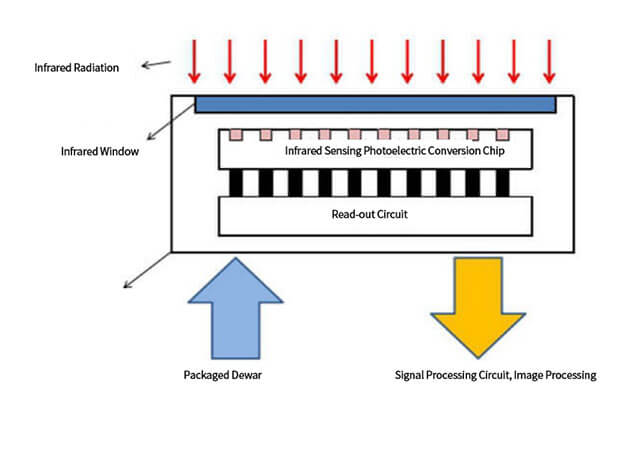Cooled infrared detector is the core component of cooled thermal imaging system. It forms a suitable low and constant temperature environment through the cooling mechanism, so that the infrared sensitive photoelectric conversion chip encapsulated in the main body of the ultra-high vacuum Dewar can convert the infrared radiation of the scene into electrical signals, and then through the readout circuit acquisition, amplification, output, image processing, and finally form an infrared image for human eyes’ observation.

Cooled infrared detector is generally composed of focal plane array, dewar module and cooler.

Infrared focal plane array is a device for receiving and converting infrared photon energy;
Dewar module provides the mechanical installation and connection reference of imaging optical system, focal plane array, electronic signal processing and cooling device. It protects the sensitive focal plane array and realizes electrical connection, and provides the vacuum environment needed to maintain the FPA working at low temperature;
The cyrocooler provides low temperature working environment for normal operation of the cooled infrared detector.
There are four common materials for cooled infrared detector: HgCdTe (MCT), quantum well (QWIP), InSb (InSb) and type II superlattice (T2SL). Global Sensor Technology mainly uses HgCdTe and type II superlattice, of which type II superlattice is the key research direction in the future.
HgCdTe (MCT): HgCdTe infrared detector is one of the most commonly used detector in the international market. It has high quantum efficiency, high light response and high response rate, and can completely cover short wave, middle wave, long wave and very long wave.
Type 2 superlattice (T2SL): type 2 superlattice is an infrared sensitive material that can compete with HgCdTe at present. It has all the advantages of HgCdTe and quantum well have and has no crosstalk. It has high quantum efficiency, large area material uniformity, wide band precision adjustable, high working temperature, good performance at long wave or two-color combination, higher performance and low cost manufacturing and many other advantages.
Go Top